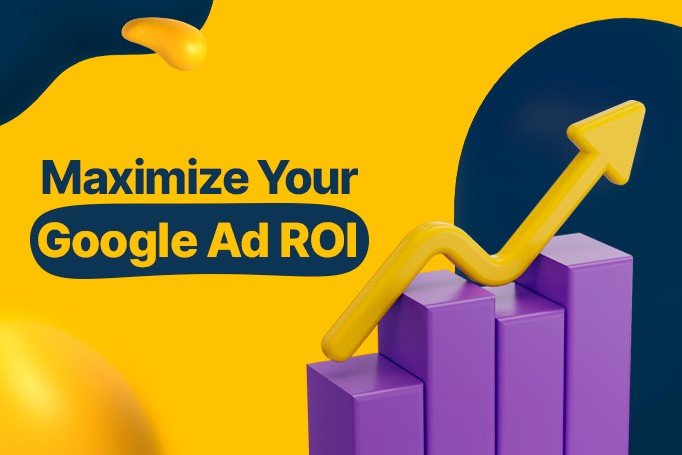Maximizing ROI with Google Ads
In the competitive world of digital marketing, businesses are constantly searching for ways to optimize their return on investment (ROI) from advertising campaigns. Google Ads, a powerful pay-per-click (PPC) platform, offers immense potential for businesses to reach their target audience, drive traffic, and generate leads. However, to truly maximize ROI, it's crucial to implement strategic approaches and best practices. This comprehensive guide explores key strategies for maximizing ROI with Google Ads, from campaign setup to optimization and beyond.

Understanding Google Ads and ROI
Google Ads operates on a PPC model, where advertisers bid on keywords and pay a fee each time their ad is clicked. The primary goal is to attract users who are likely to convert, whether it's making a purchase, signing up for a newsletter, or filling out a contact form. ROI in Google Ads is calculated by dividing the revenue generated from the ad campaign by the cost of the ads. To maximize ROI, the revenue from conversions should significantly exceed the ad spend.
1. Conduct Thorough Keyword Research
Effective keyword research is the foundation of a successful Google Ads campaign. Keywords determine when and where your ads will appear. To identify the most valuable keywords:
- Use Keyword Planner: Google's Keyword Planner tool helps identify relevant keywords and provides insights into search volume and competition.
- Focus on Long-Tail Keywords: Long-tail keywords are more specific and less competitive, leading to higher conversion rates and lower costs.
- Analyze Competitors: Use tools like SEMrush or Ahrefs to analyze competitors' keywords and identify opportunities.
- Consider User Intent: Choose keywords that align with the searcher's intent, whether informational, navigational, or transactional.
2. Craft Compelling Ad Copy
Your ad copy is the first impression potential customers have of your business. To create compelling ad copy:
- Highlight Unique Selling Points (USPs): Clearly communicate what sets your product or service apart from competitors.
- Include a Strong Call-to-Action (CTA): Encourage users to take action with clear and persuasive CTAs.
- Utilize Ad Extensions: Ad extensions provide additional information and increase the visibility of your ads. Use site links, callouts, and structured snippets.
- A/B Test Ad Variations: Continuously test different ad copy variations to determine which performs best.
3. Optimize Landing Pages
The landing page experience is crucial for converting ad clicks into leads or sales. To optimize landing pages:
- Ensure Relevance: The landing page content should align with the ad copy and keywords.
- Improve Load Times: Fast-loading pages reduce bounce rates and improve user experience.
- Simplify Navigation: Make it easy for users to find the information they need and complete the desired action.
- Use Clear CTAs: Guide users towards conversion with prominent and compelling CTAs.
- Implement Trust Signals: Include testimonials, reviews, and security badges to build trust with visitors.
4. Implement Conversion Tracking
To measure the effectiveness of your Google Ads campaigns and maximize ROI, implement conversion tracking:
- Set Up Google Ads Conversion Tracking: Track actions such as purchases, sign-ups, and form submissions.
- Use Google Analytics: Integrate Google Ads with Google Analytics for deeper insights into user behavior and conversion paths.
- Define Micro-Conversions: Track smaller actions that indicate user engagement, such as video views or downloads.
- Regularly Review Performance Data: Analyze conversion data to identify trends and areas for improvement.
5. Leverage Smart Bidding Strategies
Google Ads offers various automated bidding strategies designed to maximize ROI:
- Target CPA (Cost Per Acquisition): Automatically sets bids to achieve a specific cost per conversion.
- Target ROAS (Return on Ad Spend): Sets bids to maximize revenue based on a target ROAS.
- Maximize Conversions: Adjusts bids to get the most conversions within your budget.
- Enhanced CPC (Cost Per Click): Adjusts manual bids based on the likelihood of conversion.
6. Utilize Audience Targeting
Refining your audience targeting can significantly improve ad performance and ROI:
- Remarketing: Target users who have previously visited your site but did not convert.
- Custom Audiences: Create audiences based on specific criteria, such as interests, demographics, or behavior.
- Lookalike Audiences: Target new users who resemble your existing customers.
- In-Market Audiences: Reach users actively searching for products or services similar to yours.
7. Optimize Ad Spend and Budget
Efficient budget management is key to maximizing ROI:
- Allocate Budget to High-Performing Campaigns: Regularly review campaign performance and allocate more budget to the best-performing ones.
- Adjust Bids Based on Performance: Increase bids for keywords and ads that generate high ROI and reduce bids for underperforming ones.
- Use Ad Scheduling: Show ads at times when your target audience is most active and likely to convert.
- Geotargeting: Focus your budget on geographic areas with the highest conversion rates.
8. Analyze and Optimize Performance
Continuous analysis and optimization are essential for sustained success:
- Regularly Review Key Metrics: Monitor metrics such as CTR (Click-Through Rate), CPC (Cost Per Click), conversion rate, and ROAS.
- Identify Trends and Patterns: Look for trends in user behavior and campaign performance to inform future strategies.
- Conduct Competitor Analysis: Stay informed about competitors' strategies and adjust your approach accordingly.
- Refine Keyword Lists: Continuously update your keyword lists based on performance and emerging trends.
9. Stay Updated with Google Ads Features
Google Ads frequently updates its features and algorithms. Staying informed about these changes can give you a competitive edge:
- Follow Google Ads Announcements: Keep an eye on updates and new features announced by Google.
- Join Google Ads Communities: Participate in forums and groups to learn from other advertisers and share insights.
- Attend Webinars and Training: Invest in continuous learning through webinars, courses, and certifications.
10. Seek Professional Help
If managing Google Ads becomes overwhelming, consider seeking professional assistance:
- Hire a Digital Marketing Agency: Agencies have expertise and resources to manage and optimize campaigns effectively.
- Consult with Google Ads Specialists: Certified specialists can provide valuable insights and strategies tailored to your business.
- Use Automated Tools: Leverage tools like Optmyzr, WordStream, or AdEspresso to streamline campaign management and optimization.
Conclusion
Maximizing ROI with Google Ads requires a combination of strategic planning, continuous optimization, and staying informed about the latest trends and features. By conducting thorough keyword research, crafting compelling ad copy, optimizing landing pages, implementing conversion tracking, leveraging smart bidding strategies, refining audience targeting, managing budgets efficiently, and continuously analyzing performance, businesses can achieve significant improvements in their ad campaigns' ROI. Whether you're a small business or a large enterprise, these strategies will help you make the most of your Google Ads investment and drive meaningful results for your business.


You must be logged in to post a comment.